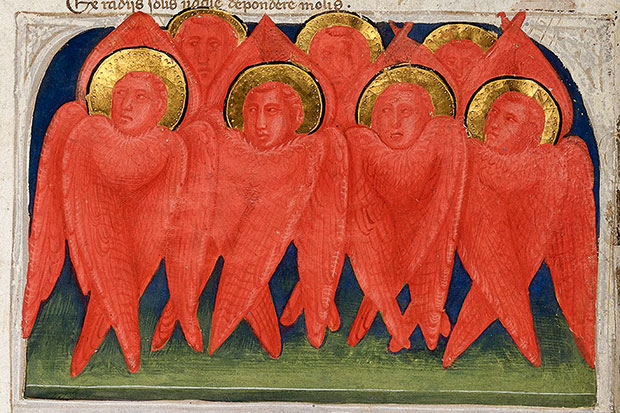Early on in his excellent and protean biography of a colour, Spike Bucklow quotes Goethe, writing in 1809:
Every rope in the English Navy has a red thread running through it, which cannot be extracted without unravelling the whole, so that even the smallest length of rope can be recognised as belonging to the crown.
Bucklow’s book follows a red thread through human history, whose twin strands are material extraction — the animal, vegetable and mineral lives of red — and the extraction of meanings from redness itself.
All colour is cultural. We have our private definitions — the unshareable conviction as to what is and is not red — but it is societies that ‘make’ colours and their associations. Colour has always been used to code and classify, to divide and demarcate. In the case of red, the borders are especially porous: ‘red line’ and ‘red carpet’ belong to different worlds, as do red lips and red-eye. Many of red’s meanings are monitory — red alert, red peril, red rag — but there is also a ‘red’ sea which is itself a red herring, or there is red-handedness. Red runs to excess — it always says too much.
It is a colour which has always dreamt of putting order into chaos. Not for nothing does ‘cosmetic’ derive from Greek cosmos (‘to order’), just as rouge helped structure the social cosmos of the court at Versailles, where ‘the brighter reds were more aristocratic’. Red contains the most colour sensations, the richest play of nuances, the greatest contradictions, and it goes further back than any other colour. Until Roman times, to dye a material meant almost invariably to change its appearance to red (which included ochres and pinks and purples). Red was not a colour so much as the colour.
The first part of Bucklow’s Red summarises the search for redness, condensing a vast field of inquiry into a lucid narrative. Beginning with red-bearing insects, notably cochineal, which were used for dyes in both old and new worlds. Madder was the most ancient and widespread plant-based red, used as cosmetics, food colouring, medicine, dye (it ‘fixed’ on to cotton whereas other extracted reds only fixed on to wool) and as artist’s pigment. Winsor & Newton were still making reds from madder roots until their London factory closed in 2011.
The pursuit of red was above all a mineral story — of hidden reds, or reds wrested from what is non-red, such as the firing of yellow ochre to produce red ochre. Earth yielded solid reds from prehistory, not least in the found form of crystals — rubies, garnets and other carbuncles — around which magical explanations proliferated: rubies came from the heads of dragons
and snakes; bright stones were washed from the rivers of Paradise; and whatever shines out of earth’s darkness must have heavenly origins.
Extraction involved intervening with the material structures of the world, a notable example being the age-old synthesis of vermilion from cinnabar, which was chemically the same but alchemically different, the whole painstaking exercise a form of magical play with subterranean redness. Bucklow calls it an ‘inorganic love story’, and the impulse to make red vermilion spanned the old world from end to end.
Red earths were collected long before becoming sources of iron, but the smelting of ‘red’ iron was a new crossroads of meanings, producing both ploughshares and swords, peace and war. Iron is extracted from ores, though it sometimes comes from above in the form of meteorites. When Cortés asked the Aztecs where they got their iron they pointed at the sky, and traditional metallurgy allied itself with planets and gods: iron with the red planet Mars and the god Ares.
Just as the need to create and recreate red spanned the old world, the rush for industrial reds drove the chemical revolution of the 19th century. New reds were conjured from coal tar, a lowly industrial waste product, and the madder industry was largely wiped out when its artificial double — named alizarin — was synthesised in 1869. Brave new reds, as Bucklow calls them, introduced a new language of colour as hue rather than as tone. This distinction recurs fleetingly in his argument, yet it seems crucial. Red for us today is a range of fixed hues, but formerly its production involved saturated tones, which were more dynamic and unpredictable. Basically not all reds were red, and earth colours were a striving towards red. The instability of red was integral to redness, an epitome of nature itself as a book of changes, and even of our own transient creaturely predicament.
At all points Buckow’s argument ranges backwards and forwards. Colour itself was traditionally thought of as matter, the envelope of beings and things, and Latin color derives from celare, to cover or dissimulate or hide. The shift to an understanding of colour as light was momentous, and it occurred early on in the West. (Bucklow does not broach the theological aspects, though debate raged in the early middle ages: if colour was matter then it belonged to the world of fallen things and should be rejected; if light, then it partook of divinity and must be embraced.)
Aristotle had proposed the earliest known chromatic scale, seeing colour as a progressive diminution of light, in which red was midway between white and black. This persisted as the scientific explanation until the 1660s, when Newton refracted light into a spectrum of seven colours. Science learnt to measure colours as wavelengths; artists and artisans learnt to think in terms of shades and ‘nuances’, primary and secondary colours, complementarity and optics. Henceforth colour could be measured, mastered, reproduced, and it lost some of its mystery. Neuroscience redefined colour as sensation: what is registered by the eye and transmitted to the brain. Henceforth colour existed in so far as it was perceived. ‘Is a red dress still red when there is no one to look at it?’ asked Goethe in his Theory of Colour. The answer then and now is ‘No’.
But the triumph of the spectrum obscures the cultural forces which shape our sense of colour. The Cartesian understanding of nature — as an ‘it’ out there — largely silenced colour. Chemistry’s commodification of colours enlarged their range but reduced their meanings. We can impose definitions on the physical world but these do not answer the question ‘why?’ — why for example red is complicit with power, whether legitimate or revolutionary. Formerly, red meanings announced themselves, suggests Bucklow, and human reality shaped itself around them.
To a modern understanding colour presents itself as a conundrum, or narrows to a problem in language, as pondered by Wittgenstein at the end of his life:
If we are asked what do the words red, black, and white mean? we can of course immediately point to things having these colours. But our ability to explain the meaning of these words goes no further.
Bucklow’s book restores many lost meanings. Starting from materials, from colour speaking through matter, it ends as a poetics of red: charting the deeds and sufferings of a light that has passed through darkness — through the ‘veil of matter’ — to reach us and become visible in the form of a red sky at night.
The post Seeing red appeared first on The Spectator.
Got something to add? Join the discussion and comment below.
Get 10 issues for just $10
Subscribe to The Spectator Australia today for the next 10 magazine issues, plus full online access, for just $10.
You might disagree with half of it, but you’ll enjoy reading all of it. Try your first month for free, then just $2 a week for the remainder of your first year.














Comments
Don't miss out
Join the conversation with other Spectator Australia readers. Subscribe to leave a comment.
SUBSCRIBEAlready a subscriber? Log in